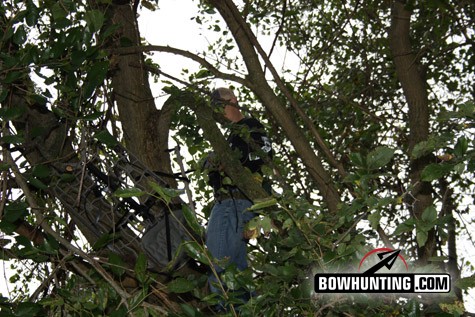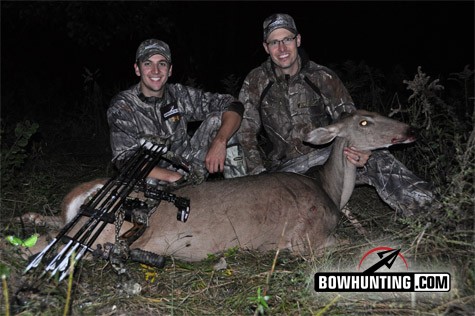LAST UPDATED: May 8th, 2015
For the second straight weekend, Todd Graf and I headed north to Wisconsin in hopes of connecting on an early season whitetail on film. For the second straight weekend, we worked our tails off to tip the odds in our favor of doing so. Unlike last weekend, however, we came back to Illinois with a mature doe to our credit. The harvest of Todd’s early season doe is a testament to two things: less than ideal hunting conditions, but more importantly, our ability to adapt.
Success in hunting, like success in life in general, is directly correlated between one’s ability to adapt to adverse conditions. Before the season begins, we as bowhunters have grand plans of tagging an unsuspecting buck that we feel we have patterned all summer. As opening day approaches, we think to ourselves, “I just need that typical early season wind, a cool afternoon, and that buck is mine!” While this may be this case for some hunters across the land, this does not describe me and Todd’s first two weekends of the season. We were faced with problematic Northeast winds and a true ignorance to the deer’s early season patterns. Nevertheless, we adjusted to the circumstances by being mobile and willing to put in a little extra time and effort. Here is a quick rundown of techniques that helped put Todd and I on some early season deer.
Click here to see the footage of Todd’s Wisconsin Doe Harvest
Trail Cameras
By now most hunters know trail cameras can be an important scouting tool when used correctly. They key word is, correctly. By quickly accessing and monitoring trail cameras you can gain a better understanding of the deer movement. Todd and I relied on his Reconyx, Bushnell and Cam Trakker trail cameras to better determine which areas were void of deer, and which were worthy of a hunt. When deploying or checking trail cameras, it is critical to be as scent free as possible and leave the area completely unmolested as possible. This means wearing rubber boots and/or rubber gloves and avoid touching any trees or lower level vegetation. The slightest foreign odor in a deer’s home range can tip them off to your presence thus drastically decreasing your chances. Keep unfamiliar noise to a minimum as well. Treat trail camera trips just as you would an actual hunting trip. Whisper if you are hunting with a partner, walk on matted leaves or grass if possible and don’t make any unnecessary noise. Be as quiet as possible. Conversely, when Todd and I checked our trail cameras we left the pickup truck running because the areas we were hunting were close to major roadways. The deer in these areas are accustomed to traffic noise and paid little attention to a running automobile. Remember, it is important to recognize your hunting scenarios and adapt accordingly.
Monitoring trail cameras revealed to Todd which areas we should focus our efforts on. Trail cameras are a great scouting tool when used correctly.
Mobility
Being flexible when it comes to our hunting spots played a key role in Todd harvesting his doe. During our 4 combined days in Wisconsin we hung multiple stand locations for various winds giving ourselves the most options possible depending on several hunting related factors including weather, food availability (both agricultural natural crops), wind direction and trail camera intel. We cashed in on food availability by finding a nice pinch point loaded with acorns. Being a mobile hunter is not a style that is appealing or suitable for everyone. It requires a lot of extra time and energy taking down and hanging new sets. Portable, lightweight tree stands, like those from Lone Wolf, Muddy Outdoors or Gorilla are ideal as are the sticks provided by those manufacturers. These stands are extremely light weight, portable and easy to carry in and out of the woods. Being mobile also requires the use of a good pruning saw, like the Hooyman, to quickly trim shooting lanes and clean out the trees you want to hunt. Again, being a mobile hunter requires extra effort; this may mean getting up an hour earlier in the morning to hang a stand in the dark or hanging a set at lunch and hunting that area the rest of the afternoon. It can be tiring, but it can definitely be worth it.
Hanging new stands requires diligence and extra effort, but it can also be a deadly tactic when bowhunting whitetails.
Intuition
Last and certainly not least, Todd and I relied on our intuition in harvesting a mature doe on film. Preparing for our fifth hunt together, we were really unsure which stand we were going to hunt. We settled down, looked at the wind, discussed food sources and quickly decided that acorns were our best bet for an afternoon hunt. By developing a sound game plan based on our hunting intuition we felt confident and hopeful heading to the stand Sunday afternoon. Trust your instincts, like Todd and I did, develop a sound game plan and you will find yourself feeling more confident in your hunting spots.
Conclusion
Sure, Todd didn’t harvest a “Booner” this past weekend in Wisconsin, but we did come back with some cool footage and meat in the freezer. We were faced with a little early season struggle but we adapted and succeeded. Hopefully, our success this past weekend provided you with a blueprint of how to adapt and make the most of your given hunting scenario. With October right around the corner, we are all sure to be experiencing some great hunting soon!
Todd and I with his 2010 early season Wisconsin doe.









